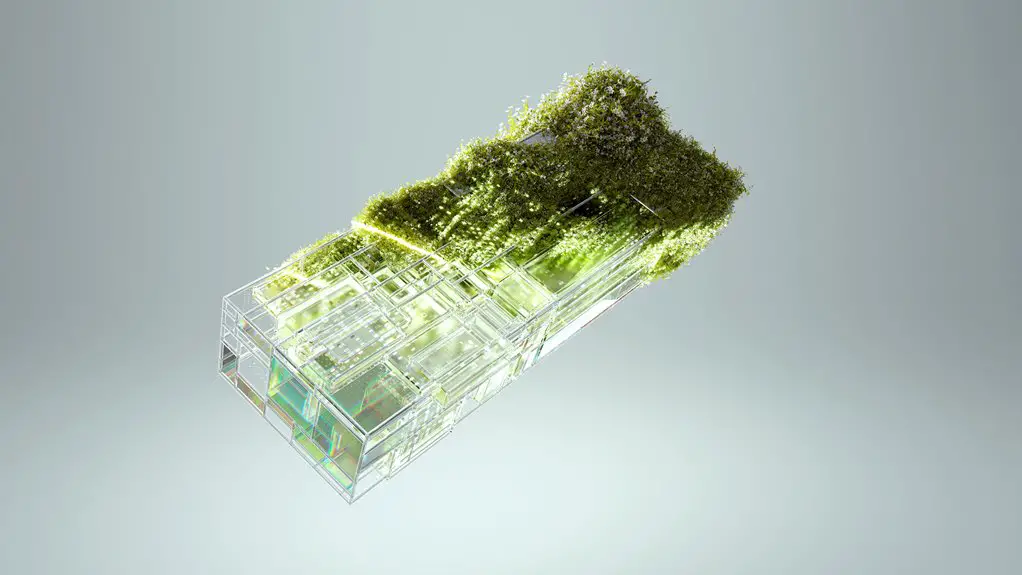You might not realize how much virtual reality (VR) is changing architectural design. It’s not just about creating stunning visuals; it’s about transforming the entire design process. With VR, you can walk through spaces before they’re built, making collaboration smoother and decisions clearer. But what does this mean for architects and clients alike? The answer could reshape the future of architecture. Let’s explore the implications together.
Table of Contents
Key Takeaways
- VR enhances spatial awareness, allowing architects and clients to visualize three-dimensional designs accurately and intuitively.
- Real-time feedback in VR facilitates quick design iterations and decision-making, improving overall efficiency in the architectural process.
- Immersive experiences in VR foster deeper client engagement and collaboration, leading to a better understanding of design concepts.
- Virtual walkthroughs enable stakeholders to gauge room sizes, spatial relationships, and material interactions, enhancing design appreciation.
- Future trends indicate increased use of AI in VR for optimizing layouts and fostering emotional connections with potential buyers.
The Evolution of Architectural Visualization
As architectural design has evolved, so too has the way we visualize our ideas. You’ve likely seen how sketches transformed into detailed blueprints, paving the way for 3D models. These advancements allow you to experiment with space and form, making it easier to communicate your vision.
Early visualizations relied heavily on physical models, but as technology progressed, digital tools emerged, offering new dimensions to your design process. You can now manipulate your concepts in real-time, understanding how light and materials interact.
This evolution not only enhances creativity but also fosters collaboration among architects, clients, and stakeholders. Embracing these changes allows you to create more immersive and accurate representations, bridging the gap between imagination and reality in architectural design.
Benefits of VR in Design Processes
When you use VR in your design processes, you gain enhanced spatial awareness that helps you visualize your projects in three dimensions.
This technology allows for improved design iteration, so you can quickly adapt your ideas based on real-time feedback.
Ultimately, VR transforms how you approach architectural design, making it more intuitive and efficient.
Enhanced Spatial Awareness
Virtual reality (VR) revolutionizes architectural design by immersing you in a three-dimensional space, enhancing your spatial awareness like never before. In VR, you can walk through designs, grasping proportions and layouts instantly. This level of engagement allows you to make informed decisions about space utilization and flow.
| Feature | Benefit | Impact |
|---|---|---|
| 3D Immersion | Realistic experience | Better understanding of space |
| Interactive Models | Hands-on adjustments | Enhanced creativity |
| Instant Feedback | Immediate design evaluation | Faster problem-solving |
With VR, you can visualize elements in real-time, making adjustments easier and fostering a deeper connection to your work. This technology truly transforms how you perceive and interact with architectural designs.
Improved Design Iteration
By leveraging VR technology, you can streamline the design iteration process considerably.
With immersive environments, you can visualize and manipulate designs in real-time, making it easier to assess and adjust elements as needed. Instead of relying solely on 2D drawings or static models, you can walk through your designs, experiencing them from various perspectives.
This hands-on approach encourages quicker feedback and collaboration with clients and stakeholders. You’ll find it easier to identify design flaws or improvements, allowing for faster iterations and more informed decisions.
Plus, the ability to simulate different lighting, materials, and layouts enhances your understanding of how your design will function in the real world.
Ultimately, VR helps you create more refined and effective architectural solutions.
Enhancing Client Collaboration With VR
With VR, you can immerse your clients in the design process like never before.
They can experience real-time modifications, making feedback immediate and impactful.
Plus, enhanced communication tools help guarantee everyone’s on the same page, leading to a smoother collaboration.
Immersive Design Experience
As you step into a virtual reality environment, the architectural design process transforms into an immersive experience that fosters deeper collaboration between clients and designers.
In this space, you can explore designs at a life-sized scale, allowing you to visualize layouts, materials, and spatial relationships more effectively. Instead of relying solely on 2D plans, you engage with the design in a way that’s intuitive and interactive.
You can point out preferences, ask questions, and suggest changes while experiencing the design firsthand. This real-time interaction creates a dialogue that enhances understanding and builds trust.
Real-time Modifications
While exploring a virtual reality design, you can make real-time modifications that greatly enhance collaboration between you and the architect.
This interactive experience lets you adjust elements like layout, materials, and colors on the spot. As you walk through the space, you can visualize changes instantly, allowing you to see how different choices impact the overall design.
This immediate feedback loop fosters a more engaging dialogue with the architect, as you can express your preferences and concerns right away. It empowers you to make informed decisions, ensuring the final design aligns with your vision.
Enhanced Communication Tools
Using enhanced communication tools in virtual reality can considerably boost client collaboration during the architectural design process.
With immersive environments, you can walk clients through designs, allowing them to experience spaces in real-time. This hands-on approach helps you gather immediate feedback, making adjustments easier and faster.
You can use annotations and interactive features to clarify design choices, ensuring everyone stays on the same page. Virtual meetings in 3D spaces eliminate miscommunication, as clients can visualize alterations rather than relying solely on 2D plans.
Immersive Walkthroughs: A New Perspective
How does stepping into a virtual space change your perception of architectural design? Immersive walkthroughs allow you to experience a design like never before. You’re not just looking at blueprints or 3D models; you’re walking through the space, feeling its dimensions, and understanding its flow. This firsthand experience can be transformative.
Consider these aspects:
- Spatial Awareness: You can gauge room sizes and relationships between spaces accurately.
- Material Interaction: You can visualize how different materials will look and feel in real life.
- Lighting Effects: You’ll see how natural light interacts with the design throughout the day.
These factors help you appreciate the design on a deeper level, making feedback more intuitive and effective.
Identifying Design Flaws Early
As you step into a virtual environment, you can quickly identify design flaws that might remain hidden in traditional blueprints. Unlike static images or 2D plans, VR immerses you in a 3D space, allowing you to experience the layout as if you were actually there.
You’ll notice awkward room placements, insufficient lighting, or poor sightlines that might otherwise go unnoticed. This immediate feedback helps you make adjustments before construction begins, saving time and money.
You can test different materials and colors, ensuring everything aligns with your vision. By catching these issues early, you enhance the overall design quality and improve client satisfaction.
VR empowers you to refine your ideas and create spaces that function well and inspire.
Streamlining the Decision-Making Process
While exploring a virtual environment, you can streamline the decision-making process by visualizing options in real time.
Enhance your decision-making by visualizing options in real time within a virtual environment.
This immersive experience allows you to evaluate designs and make choices faster than traditional methods. You’ll find it easier to:
- Compare layouts: Instantly switch between different floor plans or elevations, seeing how each option impacts space and flow.
- Test materials: Experiment with various textures and colors, helping you determine which combinations best suit your vision.
- Engage stakeholders: Invite clients or team members into the virtual space, enabling collaborative discussions that lead to quicker consensus.
Integrating VR With Traditional Tools
Integrating VR with traditional architectural tools enhances your design process by bridging the gap between digital and physical domains.
You can start by combining 3D modeling software with VR technology to create immersive environments that allow you to visualize designs in real-time. This integration lets you assess spatial relationships and materials more effectively, ensuring your ideas translate accurately into the built environment.
You can also use VR to present concepts to clients, making it easier for them to understand your vision. Additionally, collaborating with team members becomes more dynamic, as everyone can interact within the same virtual space.
Future Trends in VR for Architecture
With technology rapidly evolving, the future of VR in architecture promises to reshape how designers conceptualize and present their work.
The evolving landscape of VR in architecture is set to transform design conceptualization and presentation.
You’re likely to see some exciting trends emerge:
- Real-time Collaboration: Imagine working with clients and stakeholders in a virtual space, making instant changes and decisions together, regardless of location.
- Enhanced User Experience: Expect immersive environments that allow potential buyers to walk through properties before they’re built, making informed decisions and fostering emotional connections.
- AI Integration: As AI continues to advance, VR will harness its power to analyze designs, optimize layouts, and even suggest modifications based on user preferences.
These trends not only streamline processes but also elevate creativity, pushing the boundaries of what’s possible in architectural design.
Case Studies: Successful VR Implementations in Architecture
In recent years, several architectural firms have successfully implemented VR technology, showcasing its transformative potential.
For instance, a leading firm used VR to immerse clients in a virtual walk-through of a new residential project, allowing them to visualize spaces and make real-time adjustments.
Another case involved a commercial project where VR helped stakeholders assess design options and collaborate more effectively, streamlining decision-making.
Additionally, a renowned firm integrated VR into their design review process, reducing costly revisions by identifying design flaws early on.
These examples illustrate how VR not only enhances client engagement but also fosters collaboration among architects, engineers, and clients, ultimately leading to more innovative and efficient architectural solutions.
Frequently Asked Questions
What Hardware Is Needed for Effective VR Architectural Visualization?
For effective VR visualization, you’ll need a powerful computer, a VR headset like Oculus or HTC Vive, motion controllers, and possibly external sensors. These tools guarantee smooth experiences and accurate representations of your designs.
How Much Does VR Software for Architecture Typically Cost?
VR software for architecture typically ranges from a few hundred to several thousand dollars, depending on features and licensing. You’ll want to contemplate your specific needs and budget when researching the best options available.
Can VR Be Used for Landscape Architecture Projects?
Yes, you can definitely use VR for landscape architecture projects. It helps you visualize designs in immersive environments, allowing you to explore spatial relationships and make informed decisions about plant placement, terrain, and overall aesthetics.
What Skills Are Required to Create VR Architectural Designs?
To create VR architectural designs, you’ll need skills in 3D modeling, programming, and spatial awareness. Understanding user experience and design principles is essential, too. Mastering these areas will help you craft immersive virtual environments effectively.
Are There Specific VR Platforms Preferred by Architects?
Yes, many architects prefer platforms like Oculus Rift, HTC Vive, and Autodesk Revit for their immersive capabilities. These tools enhance design experiences, allowing you to visualize projects in a more engaging and interactive way.




